#Aviation militaire
Explore tagged Tumblr posts
Text

Bombardier-torpilleur Grumman TBF Avenger de la marine américaine – 1943
#WWII#marine américaine#us navy#aviation militaire#military aviation#bombardier- torpilleur#torpedo bomber#grumman tbf avenger#tbf avenger#avenger#1943#WW2
132 notes
·
View notes
Text
Les bracelets en peau de porc sauvage de chez Watchstrapheaven
Jan m’a proposé de vous faire découvrir un échantillon de ses bracelets en cuir de porc sauvage. Vous allez voir qu’ils sont parfaits pour des montres vintage, a fortiori pour qui tient à rester fidèle à l’esprit et aux matériaux utilisés à l’époque. Continue reading Untitled

View On WordPress
#1960s#bracelets#cadran tropical#chronographe#chronomaster aviator sea diver#horween#montre de plongée#montres de pilotes#montres militaires#nivada grenchen#peau de porc#richard#rotary#type 20#watchstrapheaven
6 notes
·
View notes
Photo
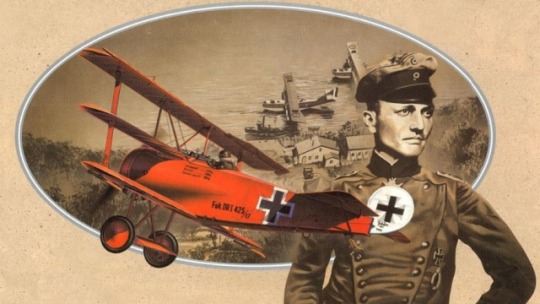
21 avril 1918 : l’aviateur surnommé le Baron rouge est abattu dans le ciel de la Somme ➽ http://bit.ly/Baron-Rouge On appelle ainsi Manfred von Richthofen, un Allemand qui a fait des ravages dans le ciel de la Première Guerre mondiale, à bord de son Fokker DR I Triplan rouge vif. Il est issu de l’aristocratie prussienne
#CeJourLà#21Avril#Baron#rouge#Première#Guerre#mondiale#aviation#aviateur#allemand#Somme#conflit#militaire#histoire#france#history#passé#past#français#french#news#événement#newsfromthepast
5 notes
·
View notes
Photo
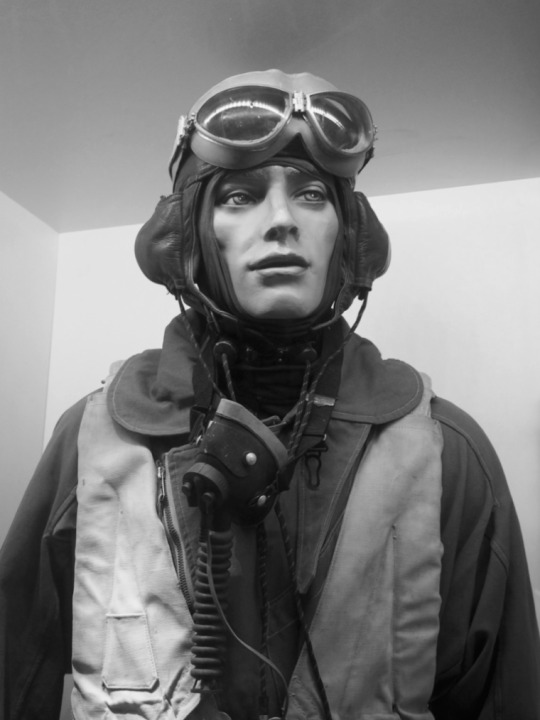
Dunkerque, musée opération dynamo, 13 février 2023.
#bizarre au havre#photography#original photography#black and white photography#dunkirk#military#world war second#opération dynamo#aviator#photographie#photographie originale#noir et blanc#dunkerque#militaire#seconde guerre mondiale#aviateur#museum#musée#musée opération dynamo
3 notes
·
View notes
Text

#mendezilustracion#almeriaartistica#illustration#art#artists on tumblr#illustrator#ilustracion#illustrators on tumblr#dibujo#almeriaart#noseartpainting#noseart#noseartdisplays#noseartist#nosearte#kustom kulture#avion militaire#aviación#artworks#aviation#aviones#avion#airforce#wwll#ww2 art#airfoce#aviator#aviacion#ilustración#my artwrok
1 note
·
View note
Text

• Fokker D.XXI Fighter
The Fokker D.XXI fighter was designed in 1935 by Dutch aircraft manufacturer Fokker in response to requirements laid out by the Royal Netherlands East Indies Army Air Force (Militaire Luchtvaart van het Koninklijk Nederlands-Indisch Leger, ML-KNIL). The D.XXI was designed as an inexpensive, rugged, and compact fighter aircraft that would possess respectable performance for its era.
On November 14th, 1934, design proposals for a new fighter aircraft were submitted by Fokker to the Luchtvaartafdeling (Dutch Army Aviation Group). Fokker's design team, led by Erich Schatzki, and based at the firm's newly completed plant in the southern district of Amsterdam, had sought to incorporate and combine various new concepts and recent features from successful fighter aircraft, including the previous C.X and D.XVII aircraft. The proposed aircraft was a low-wing monoplane which adopted an entirely enclosed cockpit; initial design work had been conducted in cooperation with British engine manufacturer Rolls-Royce, and it had been originally envisaged that the type would be powered by a Rolls-Royce Kestrel IV. Projections of the aircraft's performance included a maximum speed of 420 km/h at an altitude of 4,350 meters, a range of 888 km, and an altitude ceiling of 10,000 meters. The planned armament included rifle-calibre machine guns or 20mm cannons, which were to be embedded into the wings and fuselage.
In early 1935, the Luchtvaartafdeling signed a contract for a single prototype of the proposed fighter to be constructed for an evaluation to be performed by the Royal Netherlands East Indies Army. This prototype, designated FD-322, which was powered by a single Bristol Mercury VI-S radial engine which drove a three-blade, two-pitch propeller, performed its maiden flight at Welschap Airfield, Eindhoven, on March 27th, 1936. According to aviation author G.H. Kamphuis, the prospects for series production of the new fighter looked doubtful shortly after the first flight was performed due to a high level change in Dutch defence policy; Minister for Foreign Affairs Hendrik Colijn informed the Ministry of War that, in response to the changing international situation, a higher priority would be placed on building up a substantial bomber capability over new fighter aircraft. In addition to the Luchtvaartafdeling's interest in a trainer aircraft, the service had also attached great importance to the concept of a heavily armed 'cruiser' aircraft capable of performing multiple mission types. Further doubts and confusion were added by the emergence of a competing aircraft proposal in the form of the Koolhoven F.K.58, which had also been designed by Ir. Schatzki. It was decided that the D.XXI and F.K.58 should participate in a series of comparative tests against one another, leading to the D.XXI prototype being dispatched to Soesterberg Air Base, Utrecht, in November 1936. However, head-to-head testing between the two types was delayed by the F.K.58, which did not perform its first flight until September 1938.
During 1937, the Dutch government gave funding and its approval for a limited expansion of the Army Aviation Group, which resulted in an order being placed for 36 Fokker D.XXI fighters, to be powered by the 830 h.p. Bristol Mercury VII or VIII engines. According to Kamphuis, Dutch interest in the D.XXI had been revived, in part, due to an examination of the first aircraft by an evaluation board, which itself had been conducted due to interest expressed by the Finnish Air Force, which itself would result in export sales being made to Finland. On July 20th, 1938, the first Luchtvaartafdeling D.XXI conducted its first flight, after which it participated in test flights prior to deliver to Soesterberg. On September 8th, 1939, the final aircraft of the first batch of 36 was delivered. Even as the domestic demand for the D.XXI was being questioned, the type had attracted the attention of a number of foreign governments. In 1937, the Finnish government decided to place an order for an initial batch of seven aircraft, further negotiations were also conducted towards the acquisition of a manufacturing license, under which Finland proceeded to domestically produce further aircraft as well. Throughout 1940 and 1941, the Finnish State Aircraft Factory set about reconditioning the aircraft that had been used in the Winter War for continued service; an additional 50 D.XXIs were ordered in 1941, which were powered by the Pratt & Whitney R-1535 Twin Wasp Junior engine, acquired via Sweden. The Danish government ordered a pair of D.XXI fighters along with arrangements for its own manufacturing license. The Danish D.XXI fighters were powered by a 645 h.p. Bristol Mercury VI-S radial and carried a Madsen 20 mm cannon under each wing. Ten aircraft were completed by the Royal Army Aircraft Factory in Copenhagen prior to the German invasion of Denmark in April 1940. The Second Spanish Republic also acquired a manufacturing license for the D.XXI. Reportedly, a total of 50 fuselages were manufactured on the Spanish production line; however, the Spanish plant in which the fighter was being produced was overrun by Nationalist forces before any of the Spanish-built aircraft were completed.
The Fokker D.XXI was a low-wing monoplane fighter aircraft. Following standard Fokker design practice of the period, it featured a welded steel tube fuselage that was largely covered by fabric, including the flight control surfaces; element forward of the trailing edges of the wings were covered by detachable aluminum panels instead. The wings were of a wooden construction, being composed of two box spars attached to ribs made of plywood. The aircraft was outfitted with a fixed spatted undercarriage with cantilever legs; braking was provided by independently-operated pedals using compressed air. The cockpit of the D.XXI was fully enclosed by a plexiglas hood featuring large sliding sections, and was entirely jettisonable in an emergency situation to enable pilots to bail out. Pilots were protected against turnover injuries by means of a pylon built into the structure of the aircraft set behind the seat. Fuel was housed in a 350-litre (77 imp gal) tank located aft of the engine. The main armament consisted of two pairs of 7.92mm M36 FN-Browning machine guns, one pair housed within the wings, carrying 300 rounds of ammunition each, and the other pair within the forward fuselage and shooting through the propeller blades, carrying 500 rounds each. Upon its entry to service in 1938, the D.XXI represented a significant leap forward for the Dutch Army Aviation Group, whose fighter force had until that time consisted of aging biplanes with open cockpits. The new Fokker quickly proved to be an extremely sturdy aircraft, being capable of attaining a speed of 700 km/h in a dive.
The Fokker D.XXI was first used in combat by the Finnish Air Force during the 1939–1940 Winter War between the Soviet Union and Finland. Upon the war's outbreak, a total of 41 aircraft were in Finnish service, all powered by the Mercury VIII engine. On December 1st, 1939, the D.XXI achieved its first victory with the shooting down of a Soviet Tupolev SB. The Fokker was evenly matched against the aircraft of the Soviet Air Force, and its rugged design with a radial engine and fixed undercarriage made it well suited for Finnish conditions. As the Winter War continued and newer models of Soviet fighters appeared, the Fokker D.XXI proved to be increasingly underpowered and too lightly armed to compete; plans to arm the Fokkers with 20 mm cannons were dropped, and only one fighter was armed with two 20 mm cannons and two 7.92 mm/.312 in machine guns. The conflict between Finland and the Soviet Union was resumed in the Continuation War (1941–1944), the D.XXI was again a key element of the Finnish Air Force. During the first air battle, six Mercury-engined D.XXIs shot down a pair of Soviet Ilyushin DB-3 bombers. Several Finnish Air Force pilots became fighter aces with the Fokker D.XXI.
Although the order by the ML-KNIL was cancelled, the Luchtvaartafdeling (Dutch Army Air Force before World War II) placed an order of 36 aircraft, which were all delivered in time to participate in the war against the Germans in May 1940. On May 10th, 1940, the day that Germany launched its invasion of the Netherlands, 28 D.XXIs were serviceable and ready for operations. That first day, six D.XXIs escorted a formation of Fokker T.V bombers to attack the Meuse bridges to hinder the German advance; they were intercepted by nine German Messerschmitt Bf 109s, and during the ensuing dogfight, one Bf 109 was shot down and two more damaged for the loss of one D.XXI and two T.Vs. That same day, a flight of D.XXIs intercepted and shot down 37 out of 55 inbound Junkers Ju 52 transports which had crossed the border during the early morning. Due to many aircraft becoming unserviceable as a result of battle damage after the first day, it was decided to regroup at Buiksloot, north of Amsterdam, on May 11th. For the following four days, missions out of Buiksloot were flown by D.XXIs flying in both solo and small formations to escort friendly units as well as in the search-and-destroy role. Sorties against the numerically superior German forces continued until the middle of May 14th, at which point news of the Dutch capitulation reached Buiksloot, upon which both the remaining aircraft and the airstrip were destroyed to prevent their use by the Germans. Out of the original force of 28 D.XXI aircraft, eight fighters had remained airworthy. The D.XXI, although much slower and more lightly armed than the Bf 109, performed surprisingly well in combat due to its manoeuvrability. It was also one of the few aircraft that could follow a Stuka bomber into its dive. Nonetheless, the numerical superiority of the Luftwaffe led to the destruction of most Luchtvaartafdeling D.XXI fighters during the campaign. The LVA (Netherlands Air Force) scored a total of 38 victories against the Luftwaffe during their struggle against the German juggernaut. 16 of those went to Fokker D.XXI pilots.
A Mercury-engine Finnish-built Fokker D.XXI, FR-110, is on display at the Finnish Air Force Museum, Jyväskylä, Finland. This is the highest scoring (10 victories) D.XXI airframe. It was the mount of Lt. Viktor Pyötsiä during the Winter War. In 2022, a flyable replica was completed at Hoogeveen Airport by veteran aircraft restorer Jack van Egmond. A number of original parts was used and the plane was built according to original Fokker build specifications as Jack van Egmond is in possession of 397 out of 416 Fokker blueprints.
#second world war#world war 2#world war ii#wwii#military history#aviation#military aircraft#dutch history#winter war#aircraft#ww2 planes#dutch#dutch air force
21 notes
·
View notes
Text
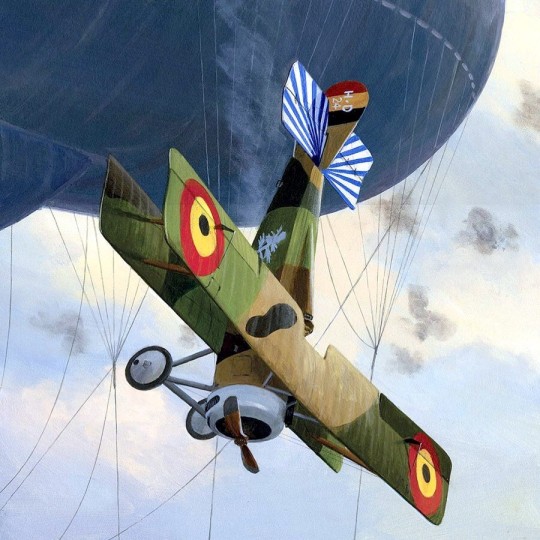
1918 05 15 Balloon busters aces cover - Mark Postlethwaite
At 0807 hrs on the morning of 15 May 1918, Adjutant Willy Coppens of the 9eme Escadrille, Aviation Militaire Beige, attacked a German kite balloon over the Houthulst Forest, only to find the morning dew interfering with his efforts. After making three attacks through increasingly heavy anti-aircraft fire, he came in slowly at the Drachen's altitude and fired his last 30 rounds into it. Although he failed to set it alight, he did succeed in cutting its cables. As he climbed over it, the balloon suddenly shot upward, colliding with his aeroplane. Coppens immediately turned off his engine, lest his propeller foul in the fabric, and waited in terrified suspense as his Hanriot HD 1 slid and tumbled along the sagging gasbag until it finally fell over the side. At that point Coppens dove earthward, switched on the engine and, when it restarted, pulled away while the perforated balloon descended to earth and exploded. It was Coppens' fourth confirmed victory, and he would score his fifth over Houthulst four days later. HD 1 No 24 was destroyed in a German night bombing raid on the 9eme Escadrille's aerodrome at Les Moeres on 13 June 1918, but Coppens would fly a series of others to become history's leading balloon ace -and Belgium's ace of aces -with 35 Drachen and two aeroplanes to his credit
27 notes
·
View notes
Text

French Air Force releases images of interception of Russian aircraft in the Baltic Sea
Russian warplanes were intercepted by NATO jets a few hours after Putin's new nuclear threat to the West.
Fernando Valduga By Fernando Valduga 03/03/2024 - 12:30 in Interceptions, Military
On 1º March, NATO reported that French Mirage 2000-5 fighters intercepted Russian Su-30SM fighters over the Baltic Sea. Moments later, two more Russian aircraft, an Il-20 reconnaissance aircraft and an An-72 transport aircraft, were also intercepted by French Air Force jets on a NATO mission.
NATO and the French Air Force released videos and images of the interception of Russian fighters, a few hours after Russian President Vladimir Putin issued a new threat to the West about the nuclear war, where he said that Russia could cause the "destruction of civilization", by stating that NATO forces are "preparing to attack Russian territory".
Check out how it looks, when 2 ?? Mirage 2000-5 intercept 2 ?? SU-30-M aircraft over the Baltic Sea yesterday
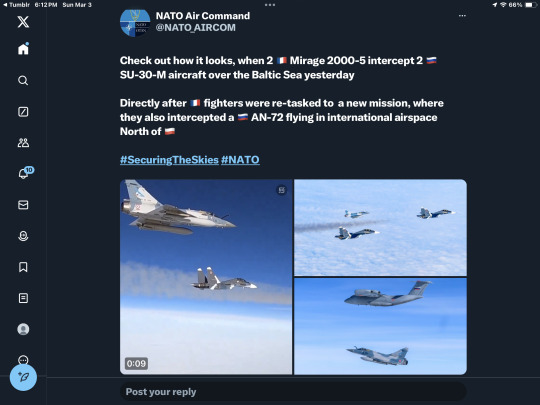
Directly after ?? fighters were re-tasked to a new mission, where they also intercepted a ?? AN-72 flying in international airspace North of ?? #SecuringTheSkies #NATOpic.twitter.com/wszcsdoc4U
— NATO Air Command (@NATO_AIRCOM) March 1, 2024
The press service of the NATO Air Force Command said that the incident occurred in international airspace in northern Poland on February 29.

According to NATO, two Mirage 2000-5 of the French Air and Space Force intercepted two Russian Sukhoi Su-30SM jets over the Baltic Sea. Subsequently, the French fighters were sent to a new mission, where they also intercepted two Russian aircraft, an An-72 and an Il-20, which were flying in international airspace in northern Poland, the statement says.
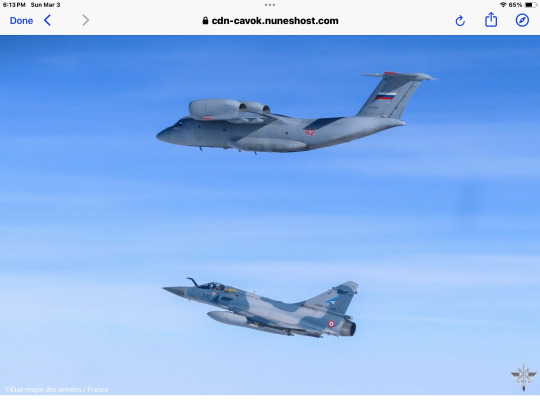
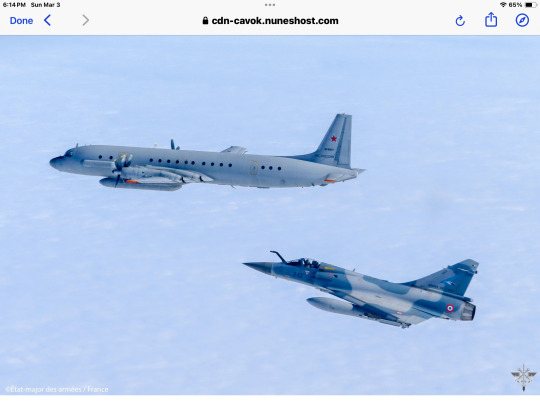
The French aircraft departed from Siauliai Air Base, Lithuania, during the NATO Air Policing mission.
In addition, it is noteworthy that these missions were intensified after Russia launched a large-scale invasion of Ukraine on February 24, 2022

The priority : #SecuringTheSkies over the Baltic States. @NATO protects ?? https://t.co/1ADkD6SrWC pic.twitter.com/oOe9Jp2Jor
— Armée française – Opérations militaires (@EtatMajorFR) March 1, 2024
In recent years, there have been several interceptions of aircraft that have not caused any serious incidents.
NATO said that air forces across Europe sent their jets more than 300 times to intercept Russian military aircraft approaching the Alliance's airspace only last year.
Tags: Armée de l'air - French Air Force/French Air ForceMilitary AviationInterceptionsMirage 2000NATO - Air Police MissionRFSAF - Russian Federation Aerospace Force/Russian Aerospace ForceSu-30SM
Sharing
tweet
Fernando Valduga
Fernando Valduga
Aviation photographer and pilot since 1992, he has participated in several events and air operations, such as Cruzex, AirVenture, Dayton Airshow and FIDAE. He has works published in specialized aviation magazines in Brazil and abroad. He uses Canon equipment during his photographic work in the world of aviation.
Related news
MILITARY
IMAGES: B-1B bombers complete the first deployment of the 2024 Bomber Task Force in Sweden
03/03/2024 - 11:30
DEMONSTRATION SQUADS
IMAGES: Thunderbirds and Blue Angels complete another joint training
03/03/2024 - 10:18
MILITARY
Confirmed Russian leak of secret war negotiation between the German armed forces and Ukraine
03/03/2024 - 09:52
MILITARY
India's HAL will manufacture MiG-29 jet engines with Russian technology
02/03/2024 - 19:16
MILITARY
Airbus A340 VIP that was from the German government is sold and already has a final destination
02/03/2024 - 15:29
MILITARY
Turkish Ministry of Defense receives letter of offer and acceptance for U.S. F-16 fighters
02/03/2024 - 12:41
12 notes
·
View notes
Text
Short Introduction to Rear Admiral Karel Doorman! (In het Engels en Nederlands)
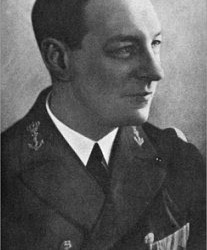

Prefacing this by mentioning who he is,
Karel Doorman is a Dutch Rear Admiral, later acknowledged as an Admiral. He was one of the most competent Admirals of the Dutch Naval forces, hence why he was selected to lead the battle of Java Sea.
Karel Doorman was een Nederlandse schout-bij-nacht, later erkend als admiraal. Hij was een van de meest bekwame admiraals van de Nederlandse marine, en daarom werd hij uitgekozen om de Slag in de Javazee te leiden.
Despite his significant role, Doorman remains a lesser-known figure from the Second World War, but he holds a very special place in my heart. There isn’t much written about him, so I’ve done my best to gather what I could. Hopefully, this helps anyone looking to learn more about him! :3
Ondanks zijn belangrijke rol blijft Doorman een minder bekende figuur uit de Tweede Wereldoorlog, maar hij heeft een heel speciaal plekje in mijn hart. Er is niet heel veel over hem geschreven, dus ik heb mijn best gedaan om te verzamelen wat ik kon vinden. Hopelijk helpt dit iedereen die meer over hem wil leren! :3
Doorman was born in 1889 in Utrecht and grew up as a Roman Catholic in a military family. He dedicated 32 years to the Navy and even made history as one of the Dutch Navy’s first flying instructors! From 1917 to 1921, he served as an instructor at Soesterberg Air Base and later at the Naval Air Base De Kooy in Den Helder.
Doorman werd geboren in 1889 in Utrecht en groeide op als rooms-katholiek in een militaire familie. Hij heeft 32 jaar van zijn leven aan de marine gewijd en maakte zelfs geschiedenis als een van de eerste vlieginstructeurs van de Nederlandse marine! Van 1917 tot 1921 diende hij als instructeur op Vliegbasis Soesterberg en later op de Marineluchtvaartbasis De Kooy in Den Helder.

He had four children—three with his first wife, whom he divorced shortly after their third child’s birth (I know…), and one with his second wife, whom he married in 1934, the same year as his divorce. Shady? Maybe a little.
Hij had vier kinderen—drie met zijn eerste vrouw, van wie hij kort na de geboorte van hun derde kind scheidde (ik weet het…), en één met zijn tweede vrouw, met wie hij in 1934 trouwde, hetzelfde jaar als zijn scheiding. Verdacht? Misschien een beetje.
In 1922, for his exceptional work organizing the young Marine Luchtvaartdienst, Doorman received a royal distinction as a Knight in the Order of Orange-Nassau. He was, however, forced to step back from active flying after a skating trip in early 1919 ended with a nasty fall through the ice, leaving him with a permanent arm injury. Combined with looming cuts in the Naval Aviation Service, this marked the end of his career in the skies.
In 1922 ontving Doorman, voor zijn uitzonderlijke werk bij het organiseren van de jonge Marine Luchtvaartdienst, een koninklijke onderscheiding als Ridder in de Orde van Oranje-Nassau. Hij werd echter gedwongen om zich terug te trekken uit actief vliegen na een schaatsreis in het vroege 1919, die eindigde met een lelijke val door het ijs, waardoor hij een blijvende armblessure opliep. Samen met de dreigende bezuinigingen op de Marine Luchtvaartdienst, betekende dit het einde van zijn carrière in de lucht.
He struggled with tropical dysentery which occasionally caused him much inconvenience and was known for being a “very special and very difficult man,” according to historian F.C. van Oosten. Not just challenging to others, but also to himself. He was described as “air-minded,” which might sound like a backhanded compliment, but in context, it just means he was sharp when it came to aerial reconnaissance.
When people talk about his “failures” regarding the campaign, people fail to account for several things / Wanneer mensen het hebben over zijn “mislukkingen” met betrekking tot de campagne, vergeten ze verschillende zaken in aanmerking te nemen:
1. The Netherlands was excluded from the United States-led conference addressing Pacific issues and determining future actions. To quote a direct excerpt from The Battle of the Java Sea by Oosten, F. C. van, ‘This conference, to which the Netherlands were not invited, was concluded on March 27th with the so-called ABC-1 Staff Agreement. Under discussion came the problems in the Pacific, and Great Britain and the United States reached an agreement over the strategic principles which would apply in the Far East should war break out with Japan. The Atlantic Ocean and Europe would be considered the main theatres of war, while in the Far East a defensive strategy would be followed. In other words the American forces in that area would not be considerably strengthened. The Pacific Fleet on the other hand would be allowed to pursue an offensive strategy. The slogan for this policy was ‘Help beat Hitler first’.
1. Nederland werd uitgesloten van de door de Verenigde Staten geleide conferentie die zich bezighield met de vraagstukken in de Stille Oceaan en de toekomstige acties. Om een direct citaat uit The Battle of the Java Sea van F. C. van Oosten te gebruiken: ‘Deze conferentie, waartoe Nederland niet was uitgenodigd, werd op 27 maart afgesloten met de zogenaamde ABC-1 Staff Agreement. Gedurende de bespreking kwamen de problemen in de Stille Oceaan aan bod, en Groot-Brittannië en de Verenigde Staten kwamen tot een overeenkomst over de strategische principes die van toepassing zouden zijn in het Verre Oosten, mocht de oorlog met Japan uitbreken. De Atlantische Oceaan en Europa zouden de belangrijkste oorlogsgebieden worden, terwijl in het Verre Oosten een defensieve strategie gevolgd zou worden. Met andere woorden, de Amerikaanse strijdkrachten in dat gebied zouden niet aanzienlijk versterkt worden. De Stille Oceaanvloot daarentegen zou een offensieve strategie mogen voeren. Het motto voor dit beleid was ‘Help Hitler eerst verslaan’.

2. He had an extremely limited time frame to prepare for the battle of Java Sea / Hij had een extreem beperkte tijd om zich voor te bereiden op de Slag in de Javazee
Mid-February 1942: Japanese forces began their advance towards Java. By this time, Doorman and the Allied naval command knew that a decisive naval engagement was inevitable / Midden februari 1942: De Japanse troepen begonnen hun opmars richting Java. Tegen deze tijd wisten Doorman en het geallieerde marinecommando dat een beslissende zeeslag onvermijdelijk was.
February 25, 1942: Japanese naval movements became clearer, and Doorman started mobilizing his mixed Allied fleet of Dutch, British, American, and Australian ships / 25 februari 1942: De Japanse maritieme bewegingen werden duidelijker, en Doorman begon zijn gemengde geallieerde vloot van Nederlandse, Britse, Amerikaanse en Australische schepen te mobiliseren.
February 26, 1942: Doorman conducted preliminary reconnaissance and skirmished with the Japanese fleet / 26 februari 1942: Doorman voerde een voorlopige verkenning uit en raakte in een schermutseling met de Japanse vloot.
February 27, 1942: The main battle commenced / 27 februari 1942: De hoofdbattle begon
Based on this timeline, Doorman had approximately 2–3 days of direct, immediate preparation after confirming the Japanese threat. However, his overall strategic preparations may have begun earlier in mid-February, giving him around 10–12 days of broader planning, though these efforts were hampered by limited resources, inadequate intelligence, and communication challenges among the multinational Allied forces.
Op basis van deze tijdlijn had Doorman ongeveer 2–3 dagen voor directe, onmiddellijke voorbereiding nadat de Japanse dreiging was bevestigd. Zijn algemene strategische voorbereidingen kunnen echter al eerder in midden februari zijn begonnen, wat hem ongeveer 10–12 dagen van bredere planning gaf, hoewel deze inspanningen werden belemmerd door beperkte middelen, inadequate inlichtingen en communicatie-uitdagingen tussen de multinationale geallieerde krachten.
Funny enough, he did express reservations regarding this campaign. Doorman reported to Helfrich that he estimated the chances of an Allied victory to be very small. He literally said: "Do we still have a chance? I believe very little. Wouldn't it be better to leave in time and help the Allies outside Java?" Helfrich countered that it was already decided in advance that the Allies would fight in the Java Sea.
Grappig genoeg uitte hij wel twijfels over deze campagne. Doorman rapporteerde aan Helfrich dat hij de kansen op een geallieerde overwinning als zeer klein inschatte. Hij zei letterlijk: "Hebben we nog een kans? Ik geloof er heel weinig in. Zou het niet beter zijn om op tijd te vertrekken en de geallieerden buiten Java te helpen?" Helfrich reageerde dat het al van tevoren was besloten dat de geallieerden in de Javazee zouden vechten.
Some facts about Doorman’s Experience during the moments leading up to the battle of Java Sea and the battle itself / Een aantal feiten over Doorman's ervaringen tijdens de momenten voorafgaand aan de Slag in de Javazee en de slag zelf
For several nights Doorman cruised with his force off the north coast of Java and Madura to prevent any unexpected landings of Japanese troops / Gedurende meerdere nachten voer Doorman met zijn vloot voor de noordkust van Java en Madura om onverwachte landingen van Japanse troepen te voorkomen.
Part of the Doorman’s crew in De Ruyter was saved, but Doorman chose to go down with the ship, per old naval tradition / Een deel van de bemanning van Doorman in de De Ruyter werd gered, maar Doorman koos ervoor om met het schip ten onder te gaan, volgens de oude maritieme traditie.

He was posthumously recognized with a commendation emphasized his exemplary leadership, noting that Doorman: '…set an inspiring example to the crew… by ordering them to abandon the sinking ship with the wounded, but to remain on board himself, whereby he went down with the ship'.
Hij werd postuum geprezen met een onderscheiding die zijn voorbeeldige leiderschap benadrukte, waarbij werd opgemerkt dat Doorman: '…een inspirerend voorbeeld gaf aan de bemanning… door hen te bevelen het zinkende schip te verlaten met de gewonden, maar zelf aan boord te blijven, waardoor hij met het schip ten onder ging'.
Ok now a photodump
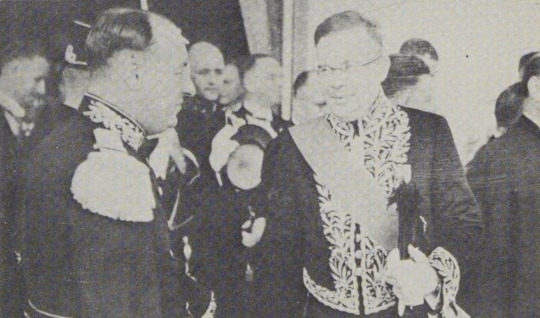





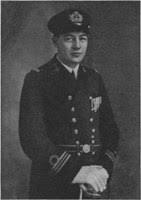
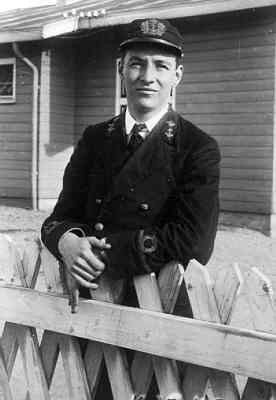
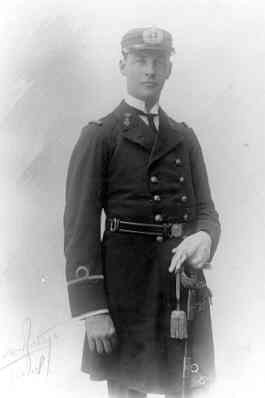
#Karel Doorman#Nederlandsch-Indië#WW2#ww2 history#allied forces#dutch east indies#colonialism#Ik hou ervan dat een van zijn tweede namen 'Marie' is#het is mijn favoriete ding ooit. Ik hou zo veel van hem#hij is letterlijk mijn prinses
3 notes
·
View notes
Text
Bien qu'elle entraîne tant de souffrances et de pertes, la guerre est une activité rentable pour certains, comme les fabricants d'armes, leurs actionnaires et les banques qui prêtent de l'argent pour ces achats.

Le classement des plus grandes entreprises de l'industrie de la guerre, en fonction de leur chiffre d'affaires 2022. L'Amérique possède les plus grandes (tous les podiums) et les plus nombreuses (12 des 25 premières), rivalisant seulement avec la Chine (4), et loin derrière en volume, la France (4).
1. Lockheed Martin $63bn (fabricant du F35, des avions Hercules. Emploie 115 000 personnes, engloutit parfois 10 % du budget d'achat du Pentagone).
2. RTX (Raytheon) 39 milliards de dollars (missiles guidés Patriot, drones, systèmes d'interception de missiles, 182 000 employés). Au moins 20 membres du Congrès américain possèdent des actions dans ces deux entreprises, ce qui leur confère des intérêts directs lorsqu'ils votent sur les dépenses budgétaires.
3. Northrop Grumman 32 milliards de dollars (bombardiers, missiles intercontinentaux, 95 000 employés)
4. China Aviation Industry Company 31 milliards de dollars (500 000 employés dans de nombreuses sociétés subordonnées. 63 % des revenus proviennent de la production civile)
5. Boeing 30 milliards de dollars (156 000 employés, 44 % des recettes proviennent des ventes civiles, en plus de la production de bombardiers, de missiles, d'avions de chasse et d'avions de ravitaillement. A reçu de nombreuses aides de l'État, directement ou par le biais d'achats d'obligations par la banque centrale).
6. General Dynamics 30 milliards de dollars (106 000 employés, avions de chasse F16, missiles Tomahawk, chars Abrams et Leopard en collaboration avec l'Allemagne).
7. BAE Systems 25 milliards de dollars (Royaume-Uni, 93 000 employés, 10% détenus par Blackrock, chars Bradley, Challengers, chasseurs et sous-marins, collaboration avec de nombreuses entreprises précédemment citées et Airbus, coproduction de l'avion Concorde).
8. Norinco - North China Industrial Group 18 milliards de dollars (78 % de la production civile, 276 000 employés, armes, missiles, canons, drones, radars).
9. L3Harris Technologies (États-Unis) 14 milliards de dollars (46 000 employés, missiles hypersoniques, simulateurs de vol, systèmes de communication)
10. South China Industrial Group 13,5 milliards de dollars (78 % de production civile, 172 000 employés, munitions, fusils, artillerie)
11. Leonardo (Italie) 13 milliards de dollars (50 000 employés, avions de combat Typhoon en collaboration avec BAE et Airbus, satellites, hélicoptères, systèmes de ciblage)
12. Airbus EADS 12 milliards de dollars (France et autres pays de l'UE tels que les Pays-Bas et l'Allemagne. 80 % des revenus de l'aviation civile, 126 000 employés, participation dans Eurocopter, Eurofighter, gros porteurs A310)
13. HII Huntington Ingalls Industries (États-Unis) 10 milliards de dollars, construction navale, porte-avions, sous-marins d'attaque, frégates, 43 000 employés)
14. Thales (France) 9,6 milliards de dollars (48 % des recettes civiles, 76 000 employés, missiles, drones)
15. China Aerospace Technology Company 9,6 milliards de dollars (79 % des recettes civiles)
16. Leidos (États-Unis) 9,5 milliards de dollars (45 000 employés, 24 % de la production civile, aviation, informatique et équipement médical)
17. Amentum (États-Unis) 6 milliards de dollars
18. Booz Allen Hamilton (USA) 5,9 milliards de dollars
19. Rheinmetall (Allemagne) 5,1 milliards de dollars (25 000 employés, véhicules militaires)
20. Dassault Aviation (France) 5 milliards de dollars
21. Elbit Systems (Israël) 5 milliards de dollars (18 000 employés, drones, équipements de guerre électronique, contrat de modernisation des MiG et des IAR 300 pour la Roumanie, participation à la guerre de Gaza)
22. Rolls Royce (Royaume-Uni) 4,9 milliards de dollars (69 % de sources civiles, moteurs d'avion)
9 notes
·
View notes
Text
Le Plan Manstein et la Blitzkrieg : une victoire allemande éclair

Le 17 février 1940 marque le début d’une manœuvre audacieuse qui changera le cours de la Seconde Guerre mondiale : le Plan Manstein. Élaboré par le général allemand Erich von Manstein, ce plan stratégique est étroitement lié à la Blitzkrieg, ou “guerre éclair”, une doctrine militaire qui prône des attaques rapides et coordonnées pour submerger l’adversaire.
C’est ce plan que va retenir le Führer pour son offensive du 10 mai 1940.
La Blitzkrieg, adoptée par l’Allemagne nazie dès le début de la guerre, avait pour objectif de capitaliser sur la supériorité tactique et technologique de ses forces armées, notamment en matière de chars et d’aviation. Cette stratégie visait à contourner les lignes défensives ennemies, à perturber leurs communications et à les encercler, créant ainsi des poches de résistance isolées et facilitant leur destruction.
Le Plan Manstein s’inscrit dans cette logique de la Blitzkrieg. En choisissant de traverser les Ardennes, une région considérée comme difficilement praticable par les forces motorisées, les Allemands ont surpris les Alliés et contourné les défenses jugées les plus solides, comme la ligne Maginot. Cette manœuvre audacieuse a permis aux forces allemandes de percer profondément dans le territoire ennemi, créant une brèche décisive dans les lignes françaises et britanniques.
Le succès du Plan Manstein repose sur plusieurs facteurs. Tout d’abord, une planification minutieuse et une exécution rapide ont pris les défenseurs par surprise, les laissant peu préparés pour faire face à une attaque aussi soudaine et audacieuse. Ensuite, la coordination efficace entre les différentes branches de l’armée allemande, y compris les chars, l’infanterie et l’aviation, a permis une avancée rapide et décisive.
Du côté des Alliés, le Plan Manstein a révélé les faiblesses de leur stratégie défensive et leur manque de préparation face à la Blitzkrieg allemande. La rapidité et l’audace des Allemands ont mis en évidence la nécessité pour les Alliés de repenser leurs propres tactiques et stratégies militaires.
En conclusion, le Plan Manstein du 17 février 1940 a été un exemple frappant de l’efficacité de la Blitzkrieg allemande. En capitalisant sur la surprise, la vitesse et la coordination, les Allemands ont remporté une victoire éclair qui a ébranlé les défenses des Alliés. Cette opération a également servi de leçon aux Alliés, les incitant à s’adapter et à développer de nouvelles stratégies pour contrer la menace allemande dans les mois et les années à venir.
***
The Manstein plan and Blitzkrieg: a lightning german victory
On February 17, 1940, marks the beginning of a bold maneuver that would change the course of World War II: the Manstein Plan. Devised by German General Erich von Manstein, this strategic plan is closely linked to Blitzkrieg, or "lightning war," a military doctrine advocating rapid and coordinated attacks to overwhelm the enemy.
Blitzkrieg, adopted by Nazi Germany early in the war, aimed to capitalize on the tactical and technological superiority of its armed forces, particularly in terms of tanks and aviation. This strategy sought to bypass enemy defensive lines, disrupt their communications, and encircle them, creating isolated pockets of resistance and facilitating their destruction.
The Manstein Plan fits within this Blitzkrieg logic. By choosing to traverse the Ardennes, a region considered difficult for motorized forces, the Germans surprised the Allies and bypassed defenses deemed strongest, such as the Maginot Line. This audacious maneuver allowed German forces to penetrate deeply into enemy territory, creating a decisive breach in French and British lines.
The success of the Manstein Plan rests on several factors. Firstly, meticulous planning and rapid execution caught defenders off guard, leaving them ill-prepared to face such a sudden and audacious attack. Furthermore, effective coordination between different branches of the German army, including tanks, infantry, and aviation, enabled swift and decisive advancement.
On the Allied side, the Manstein Plan revealed weaknesses in their defensive strategy and their lack of preparation against the German Blitzkrieg. The speed and audacity of the Germans highlighted the need for Allies to rethink their own military tactics and strategies.
In conclusion, the Manstein Plan of February 17, 1940, was a striking example of the effectiveness of German Blitzkrieg. By capitalizing on surprise, speed, and coordination, the Germans achieved a lightning victory that shook Allied defenses. This operation also served as a lesson to the Allies, prompting them to adapt and develop new strategies to counter the German threat in the months and years ahead.
#wwii#nazi#Manstein#Blitzkrieg#France#Allemagne#Seconde guerre mondiale#Deuxième guerre mondiale#France occupée#Guerre#world war 2#world war ii
2 notes
·
View notes
Text

Consolidated B-24D Liberators en formation de vol – début 1943
©National Museum of the United States Air Force - 050610-F-1234P-019
Il s'agit probablement d'un vol de test pour vérifier la visibilité des nouvelles insignes nationales.
#WWII#united states army air forces#usaaf#aviation militaire#military aviation#bombardier#bomber#bombardier lourd#heavy bomber#consolidated b-24 liberator#b-24 liberator#b-24#consolidated#liberator#1943#WW2
61 notes
·
View notes
Video
youtube
URBEX Guy Clément DEUTSCHLAND | ALTES LAGER | L'ECOLE ALLEMANDE DE L'AVI... - N'hésites pas à t'abonner à ma chaîne et activer les notifications 🔔pour être informé de mes prochaines explorations et découvertes! Feel free to subscribe my channel and activate notifications 🔔to be aware about my next explorations and discoveries! L’« École technique de l’École allemande de l’aviation commerciale GmbH » a été fondée le 14 aout 1933 par le Ministre de l’aviation du Reich, Hermann Göring. Cette zone est appelée Waldage et depuis le XIXeme siècle, elle est à vocation militaire. Les bâtiments sont construits par la Luftwaffe : l'armée de l'air de la Reichswehr. Le Traité de Versailles, n’autorisait pas l'Allemagne de disposer d'une force aérienne. La base était initialement déguisée en installation civile. Dès 1933, elle comptait déjà 1 500 étudiants, hébergés dans des casernes. L’ensemble des bâtiment ont été édifié en 1933/1934 dans le secret absolu. Le 1er mars 1935, l’armée de l’air allemande prends son « envole » et devient une installation militaire. La Seconde Guerre mondiale épargne le site, et dès le 20 avril 1945, au cours de la bataille de Berlin, l'Armée rouge occupa la garnison et son aérodrome et transforma le site en centre de formation pour les officiers des troupes blindées de chars et de l'artillerie soviétiques. Après le retrait de l'armée soviétique, URSS, le site est à l’abandon… pourtant classé monument historique. The "Technical School of the German Commercial Aviation School GmbH" was founded on 14 August 1933 by the Reich Minister of Aviation, Hermann Göring. This area is called Waldage and since the 19th century, it has been military. Buildings are built by the Luftwaffe: the air force of the Reichswehr. The Treaty of Versailles did not allow Germany to have an air force. The base was initially disguised as a civilian installation.By 1933, it already had 1,500 students in barracks. The entire building was built in 1933/1934 in absolute secrecy. On 1 March 1935, the German air force took its «fly» and became a military installation. The site was spared by World War II, and as early as 20 April 1945, during the Battle of Berlin, the Red Army occupied the garrison and its airfield and transformed the site into a training centre for officers of Soviet armoured tank troops and artillery. After the withdrawal of the Soviet army, USSR, the site is abandoned... yet classified as a historic monument. After the withdrawal of the Soviet army, USSR, the site is abandoned... yet classified as a historic monument. Die «Technische Schule der Deutschen Handelsluftfahrtschule GmbH» wurde am 14. August 1933 vom Reichsluftfahrtminister Hermann Göring gegründet. Dieses Gebiet wird Waldage genannt und ist seit dem 19. Jahrhundert militärisch. Die Gebäude wurden von der Luftwaffe gebaut: der Luftstreitkräfte der Reichswehr. La «Scuola tecnica della Scuola tedesca dell'aviazione commerciale GmbH» è stata fondata il 14 agosto 1933 dal ministro dell'aviazione del Reich, Hermann Göring. Questa zona è chiamata Waldage e dal XIX secolo, è a vocazione militare. Gli edifici sono costruiti dalla Luftwaffe: l'aeronautica della Reichswehr. Il trattato di Versailles non autorizzava la Germania ad avere una forza aerea. La base era inizialmente mascherata da installazione civile. Già nel 1933, contava già 1.500 studenti, ospitati in caserme. L'insieme degli edifici fu costruito nel 1933/1934 in assoluta segretezza. Il 1o marzo 1935, l'aeronautica tedesca prende il suo «volo» e diventa un impianto militare. La seconda guerra mondiale risparmiò il sito, e dal 20 aprile 1945, durante la battaglia di Berlino, l'Armata rossa occupò la guarnigione e il suo aeroporto e trasformò il sito in un centro di addestramento per gli ufficiali delle truppe corazzate dei carri armati e dell'artiglieria sovietici. Dopo il ritiro dell'esercito sovietico, URSS, il sito è in abbandono... eppure classificato monumento storico. La «Escuela técnica de la Escuela alemana de la aviación comercial GmbH» fue fundada el 14 de agosto de 1933 por el ministro de aviación del Reich, Hermann Göring. Esta zona se llama Waldage y desde el siglo XIX es de vocación militar. Los edificios son construidos por la Luftwaffe: el ejército del aire de la Reichswehr. El Tratado de Versalles no permitía a Alemania tener una fuerza aérea. La base estaba inicialmente disfrazada como instalación civil. Ya en 1933, contaba con 1.500 estudiantes, alojados en cuarteles. El conjunto de los edificios se construyeron en 1933/1934 en secreto absoluto. Retrouvez-moi sur les réseaux / Follow me for daily content: 👍 Facebook: Urbex Guy Clement https://www.facebook.com/profile.php?... 👉 Youtube URBEX Guy Clément https://www.youtube.com/channel/UCNhQ... 📸 Instagram: @abandoned.urbex.world https://www.instagram.com/abandoned.u... 🎵TikTok: @urbexguyclement https://www.tiktok.com/@urbexguycleme... 🐦Twitter: @GuyPellegrin https://twitter.com/GuyPellegrin #abandoned #exploration #urbex
0 notes
Text
Airbus complice de la junte birmane
Comment un proche partenaire d'Airbus, AVIC, fournit des armes à l'armée birmane et ce qu'Airbus devrait faire à ce sujet.
Airbus, géant aéronautique européen, est au cœur d’une controverse concernant ses liens avec l’industrie de défense chinoise et indirectement avec la junte militaire birmane. L’entreprise est accusée de contribuer indirectement à des violations des droits humains au Myanmar à travers ses partenariats avec AVIC (Aviation Industry Corporation of China). Les ONG Justice For Myanmar et Info Birmanie…
#Airbus#Birmanie#Devoirdevigilance#Droitshumains#Géopolitiqque#Industriemilitaire#Myanmar#nsabilitésocialedesentreprises#Respo#Vhine
0 notes
Text

Le premier cavalier : un grand dictateur
Et je vis, lorsque l’Agneau ouvrit l’un des sept sceaux, et j’entendis l’un des quatre animaux disant comme une voix de tonnerre : Viens et vois. Et je vis : et voici un cheval blanc, et celui qui était assis dessus ayant un arc ; et une couronne lui fut donnée, et il sortit en vainqueur et pour vaincre. Apocalypse 6:1-2
Lorsque les croyants auront été enlevés, les jugements décrits dans l’Apocalypse débuteront par l’émergence d’un grand dictateur. Cet homme aura le don de plaire aux foules et de les fasciner. Probablement grâce aux médias, il apparaîtra comme l’homme providentiel auquel il convient de donner le pouvoir : « une couronne lui est donnée ».
Avec son arc, il dispose d’une puissance militaire bien organisée qui lui permet d’atteindre des objectifs lointains, de faire peser une menace à distance. On pense irrésistiblement aux armes balistiques modernes qui assurent une suprématie militaire aux États qui les possèdent sans qu’ils aient même besoin de les utiliser.
Équipé ainsi, il dévoile ses ambitieux projets de conquête et met en œuvre ses préparatifs pour dominer sur un vaste territoire. Nous pouvons bien penser que son action sera à l’origine des jugements annoncés dans les trois sceaux suivants caractérisés par la guerre, la famine, les maladies et la mort.
L’histoire récente nous donne un exemple de ce que pourrait être la montée d’un dictateur, et la rapidité avec laquelle les événements peuvent se dérouler : celui d’Hitler. Voilà un homme sorti de rien qui apparaît dans un pays très appauvri, humilié, ravagé par un immense chômage. Il donne du travail à tous, relève la tête de ses compatriotes qui lui accordent en général une confiance sans bornes. Il reconstitue une armée puissante avec la meilleure aviation du monde (pensez à l’arc) et annexe plusieurs pays voisins. Jusqu’au jour, six ans après son arrivée au pouvoir, où la guerre commence ; elle embrasera le monde entier et fera des millions de morts.
La venue du Seigneur est plus proche que jamais ; le dictateur de l’Apocalypse est peut-être déjà né ; avertissons les hommes que le dérèglement du monde ne fera qu’augmenter ; supplions-les pour Christ de se réconcilier avec Dieu pendant qu’il est temps de le faire.
0 notes
Text
Pearl-Harbor décembre 1941 Jérusalem avril 2024
Pearl-Harbor décembre 1941 Jérusalem Avril 2024 Les similitudes Pearl-Harbor décembre 1941 Jérusalem Avril 2024, les attaques sont similaires. Attaques surprise sans déclaration de guerre. Les différences Pearl-Harbor décembre 1941 - L'aviation japonaise est arrivée sans être détectée, les moyens technique de détection d'alors n'ont rien à voir avec les actuels. - L'intégralité de la flotte pacifique fut coulée. Jérusalem avril 2024 - L'attaque massive et sans précédent, conjointe de 230 drones mettant 5 à 6 heures pour arriver sur leurs cibles, et d'une centaine de missiles hypersoniques se déplaçant dans la stratosphère, porteurs de 60 tonnes d'explosif est une première mondiale. Les satellites ont permis de détecter dès leur lancement les drones comme les missiles. - 50% des missiles sont retombés sur le territoire iranien. - 99% des drones et missiles ont été détruits. Analyse de l'attaque Moyens mis en œuvre et résultat Les 230 drones ont été détruits en Irak et en Jordanie, par les aviations américaine, britannique, et française cette dernière à la demande de la Jordanie, les aviations saoudienne, émiratie ont été de la partie se joignant à l'aviation israélienne dans cette action. En conséquence cette coalition s'est mobilisée en quelques heures, c'est aussi une première mondiale. C'est la preuve que l'Occident est un allié fiable d'Israël en dépit de certaines divergences. L'alliance de trois pays arabe avec Israël prouve la solidité des accords d'Abraham. Les 50 missiles hypersoniques ont quasiment tous été détruits par la Fronde de David. Trois missiles sont tombés près d'une base militaire faisant peu de dégâts. Une fillette bédouine de 7 ans grièvement blessée est décédé rapidement. En dépit de ses rodomontades l'Iran tigre de papier comme jadis l'Irak a perdu la face. Effusion de joie dans les rues de Naplouse suite à l'attaque iranienne de missiles Crédit Lph-Info-Israel Le ressenti d'Israël - Israël est très fier d'avoir mobilisé la coalition en quelques heures. - Israël est très fier du succès de sa Fronde de David qui a arrêté la quasi totalité des missiles comme lors de sa première mondiale contre un missile hypersonique tiré par les Houthis. Le ressenti de la communauté internationale - La communauté internationale s'est rangée comme un seul homme pour soutenir Israël dans cette épreuve. - Elle a aussitôt appelé à la retenue Amérique comprise. (S'est-elle retenue après Pearl-Harbor)? - Enfin elle est toute prête à acquérir la Fronde de David afin de se protéger des missiles hypersoniques. Conclusion Dès qu'il s'agit d'Israël, la communauté internationale se permet de délivrer des conseils, voire des injonctions à ne pas faire ceci ou cela. Nous pouvons conseiller à la France de s'occuper en priorité de la sécurité. Le Président de la République a t-il été élu pour protéger sa population, ou pour protéger les terroristes, et les États voyous qui veulent éradiquer un pays allié (Israël). Les Britanniques et les Américains ont rasé Dresde avec des dizaines de milliers de victimes civiles, comment peuvent-ils s'opposer aux actions d'Israël qui lutte pour sa survie et celle de l'Occident tout entier. Les États-Unis ont utilisé à 2 reprises l'arsenal nucléaire pour éviter la mort de centaines de milliers de soldats. Comment peut-elle nous freiner sur Rafah ou sur l'Iran? En effet, que pèsent les éventuelles victimes collatérales de Rafah dont beaucoup de supporter du 'Hamas lors de l'éradication de 'Hamas face à: - 9,5 millions d'Israéliens. - 447 millions d'Européens. - 341,4 millions d'Américains. Et si tous ceux là tombent, par le jeu des dominos ceux-ci suivront: - 111 millions d'Égyptiens. - 36.4 millions de Saoudiens. - 11.3 millions de Jordaniens. - 10 millions d'Émiratis. - 4.3 millions de Koweïtiens. - 1.5 millions de Bahreïnis Enfin pourquoi la Communauté internationale s'oppose t-elle à faire chuter un régime islamiste voyou grand fauteur de trouble sur tout le Proche-Orient? Israël est-il comme Hercule condamné par Eurysthée aux 12 travaux, dont le second fut de tuer l'hydre de Lerne. La Communauté internationale ne peut-elle prendre en charge par Otan interposé cette opération de salut public? Finalement, en dépit des manifestations de bras cassés, Benyamin Netanyahou sort conforté par cette attaque de l'Iran, tous lui reconnaissent ses énormes qualités de dirigeant. Read the full article
0 notes